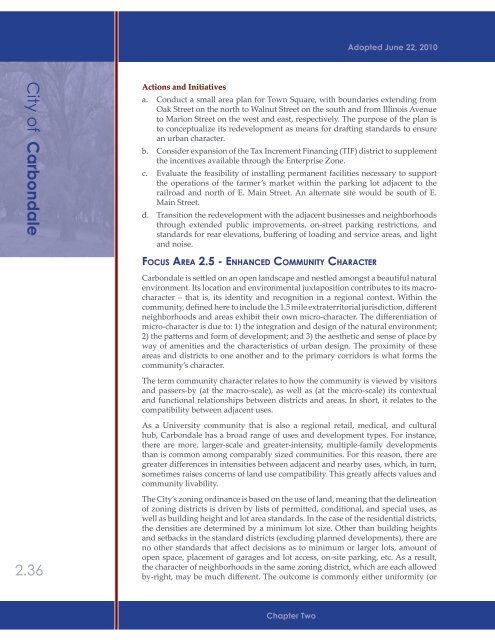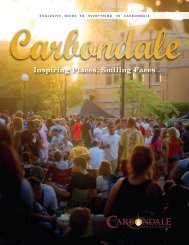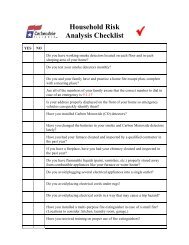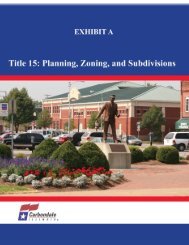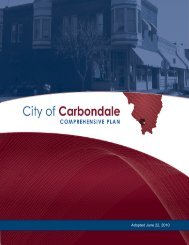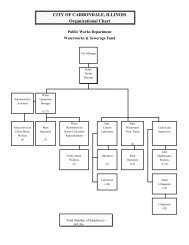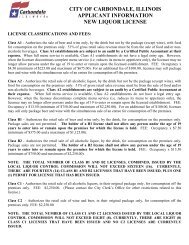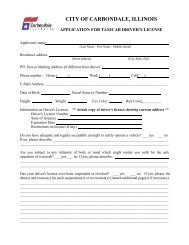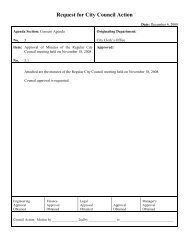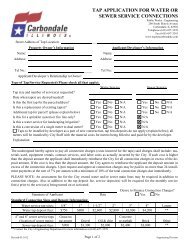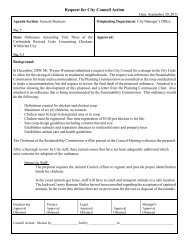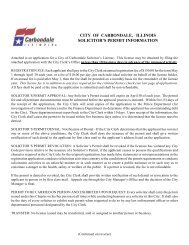Adopted June 22, 2010<strong>Plan</strong>. This district is for the purpose of protecting the form and designcharacter of neighborhoods while establishing allowances for investmentand reinvestment. This district would protect the form of development,which may be supplemented by designation as a neighborhood preservationdistrict to retain the historic structural and aesthetic integrity of individualstructures.d. Conduct a thorough review and critique of the 1996 Architectural PreservationGuidelines and, subsequently, update and codify them into the zoningordinance. Where appropriate and applicable, seek to develop definitivestandards rather than guidelines.e. Upon designation, strengthen the organization of historic and neighborhoodpreservation districts through a centralized and official historic preservationorganization for which technical preservation assistance may be offered andresources may be available. In this way, a professional staff person may serveas an advocate for preservation efforts who may provide assistance to ownersin complying with the procedures and preservation standards.f. Conduct an examination of the zoning ordinanceand building code to correct any unintendedimpediments to rehabilitation, redevelopment,and/or preservation.g. Publish educational resources to makeinformation readily available as to appropriatepreservation and modification techniquesand the use of appropriate materials to allowneighborhoods to be historically reclaimed.HERITAGE TREEA Heritage tree is a tree that - becauseof its age, size, type, historical associationor horticultural value – is of specialimportance to the City.h. Supplement the materials already provided on the City’s website to includeother historic preservation library materials, including those outlined in The<strong>Carbondale</strong> Historic Preservation <strong>Plan</strong>.i. Take steps to protect, preserve, and restore the urban forest, particularly inthe older, well-established neighborhoods. This may include a preservationordinance for heritage trees and/or tree protection requirements.j. Continue to offer financial assistance for property owners through the façaderehabilitation program (<strong>Carbondale</strong> Main Street) to facilitate improvement ofhistoric buildings. Also, seek to identify or create a source of funding to providegrant or loan assistance in preservation and restoration efforts.<strong>Comprehensive</strong> <strong>Plan</strong>Strategy 2: Redevelop Town SquareRationaleTown Square is the site of the original town settled along the Illinois Central Railroad.Locally and historically significant buildings including The Dunaway Block and theF.A. Prickett Building, along with the Town Square Pavilion, remain (see Figure2.13, Historic Properties). The recent demolition of the Tuscan Lodge changed – atleast in the near term – the traditional fabric of this historically significant area. Nearthe same time, several other buildings on the east side of Washington Street, bothnorth and south of E. Main Street, were removed, opening great new opportunitiesfor returning Town Square to its glory days. Its location serves as a gateway toDowntown and its proximity to the railroad affords great opportunity.2.35Land Use Character and Community Growth
Adopted June 22, 2010City of <strong>Carbondale</strong>Actions and Initiativesa. Conduct a small area plan for Town Square, with boundaries extending fromOak Street on the north to Walnut Street on the south and from Illinois Avenueto Marion Street on the west and east, respectively. The purpose of the plan isto conceptualize its redevelopment as means for drafting standards to ensurean urban character.b. Consider expansion of the Tax Increment Financing (TIF) district to supplementthe incentives available through the Enterprise Zone.c. Evaluate the feasibility of installing permanent facilities necessary to supportthe operations of the farmer’s market within the parking lot adjacent to therailroad and north of E. Main Street. An alternate site would be south of E.Main Street.d. Transition the redevelopment with the adjacent businesses and neighborhoodsthrough extended public improvements, on-street parking restrictions, andstandards for rear elevations, buffering of loading and service areas, and lightand noise.Focus Area 2.5 - Enhanced Community Character<strong>Carbondale</strong> is settled on an open landscape and nestled amongst a beautiful naturalenvironment. Its location and environmental juxtaposition contributes to its macrocharacter– that is, its identity and recognition in a regional context. Within thecommunity, defined here to include the 1.5 mile extraterritorial jurisdiction, differentneighborhoods and areas exhibit their own micro-character. The differentiation ofmicro-character is due to: 1) the integration and design of the natural environment;2) the patterns and form of development; and 3) the aesthetic and sense of place byway of amenities and the characteristics of urban design. The proximity of theseareas and districts to one another and to the primary corridors is what forms thecommunity’s character.The term community character relates to how the community is viewed by visitorsand passers-by (at the macro-scale), as well as (at the micro-scale) its contextualand functional relationships between districts and areas. In short, it relates to thecompatibility between adjacent uses.As a University community that is also a regional retail, medical, and culturalhub, <strong>Carbondale</strong> has a broad range of uses and development types. For instance,there are more, larger-scale and greater-intensity, multiple-family developmentsthan is common among comparably sized communities. For this reason, there aregreater differences in intensities between adjacent and nearby uses, which, in turn,sometimes raises concerns of land use compatibility. This greatly affects values andcommunity livability.2.36The City’s zoning ordinance is based on the use of land, meaning that the delineationof zoning districts is driven by lists of permitted, conditional, and special uses, aswell as building height and lot area standards. In the case of the residential districts,the densities are determined by a minimum lot size. Other than building heightsand setbacks in the standard districts (excluding planned developments), there areno other standards that affect decisions as to minimum or larger lots, amount ofopen space, placement of garages and lot access, on-site parking, etc. As a result,the character of neighborhoods in the same zoning district, which are each allowedby-right, may be much different. The outcome is commonly either uniformity (orChapter Two
- Page 1:
Adopted June 22, 2010
- Page 4 and 5:
Adopted June 22, 2010City of Carbon
- Page 6 and 7:
Adopted June 22, 2010City of Carbon
- Page 8 and 9:
Adopted June 22, 20101CommunityOver
- Page 10 and 11:
Adopted June 22, 2010validates many
- Page 12 and 13: DemographicComparisonEducation% Pop
- Page 14 and 15: Adopted June 22, 2010will remain st
- Page 16 and 17: Adopted June 22, 2010factors for re
- Page 18 and 19: Adopted June 22, 2010strategies, in
- Page 20 and 21: Adopted June 22, 2010To facilitate
- Page 22 and 23: Adopted June 22, 2010A priority-set
- Page 24 and 25: Adopted June 22, 2010Infill Develop
- Page 26 and 27: Adopted June 22, 2010the community
- Page 28 and 29: 2Land Use CharacterAdopted June 22,
- Page 30 and 31: Adopted June 22, 2010• Strategy 3
- Page 32 and 33: Adopted June 22, 2010community char
- Page 34 and 35: Adopted June 22, 2010DesignationTab
- Page 36 and 37: Adopted June 22, 2010Summary of exi
- Page 38 and 39: Adopted June 22, 2010a priority (al
- Page 40 and 41: Adopted June 22, 2010Park Service A
- Page 42 and 43: Adopted June 22, 2010area (see Map
- Page 44 and 45: Adopted June 22, 2010environmental
- Page 46 and 47: Adopted June 22, 2010as a valuable
- Page 48 and 49: Adopted June 22, 2010c. Improve acc
- Page 50 and 51: Adopted June 22, 2010District / Dev
- Page 52 and 53: Adopted June 22, 2010Actions and In
- Page 54 and 55: Adopted June 22, 2010The “communi
- Page 56 and 57: Adopted June 22, 2010Actions and In
- Page 58 and 59: Adopted June 22, 2010building place
- Page 60 and 61: Adopted June 22, 2010during the lat
- Page 64 and 65: Adopted June 22, 2010monotony by re
- Page 66 and 67: Adopted June 22, 2010g. Amend the c
- Page 68 and 69: Adopted June 22, 2010effective in a
- Page 70 and 71: AIRPORT RDService2.2ParkAreasPARKS
- Page 72 and 73: COUNTRY CLUB RDS. OAKLAND AVEMurphy
- Page 75 and 76: Adopted June 22, 20103CommunityMobi
- Page 77 and 78: Adopted June 22, 20103.3 Existing C
- Page 79 and 80: Adopted June 22, 2010Existing Stree
- Page 81 and 82: Adopted June 22, 2010caused by turn
- Page 83 and 84: Adopted June 22, 2010secondary arte
- Page 85 and 86: Adopted June 22, 2010of traffic sig
- Page 87 and 88: Adopted June 22, 2010number and wid
- Page 89 and 90: Adopted June 22, 2010e. Coordinate
- Page 91 and 92: Adopted June 22, 2010STREETSCAPE MA
- Page 93 and 94: Adopted June 22, 2010c. Re-evaluate
- Page 95 and 96: Adopted June 22, 2010streets’ imp
- Page 97 and 98: Adopted June 22, 2010Downtown Carbo
- Page 99 and 100: COUNTRY CLUB RDN. BILLY BRYAN STS.
- Page 101 and 102: 3.3SalukiExpress RoutesTRANSIT ROUT
- Page 103 and 104: Adopted June 22, 20104Housing &Neig
- Page 105 and 106: Adopted June 22, 2010Summary of Hou
- Page 107 and 108: Adopted June 22, 2010the 1970’s.
- Page 109 and 110: Adopted June 22, 2010Figure 4.3 | O
- Page 111 and 112: Adopted June 22, 2010units. This su
- Page 113 and 114:
Adopted June 22, 2010poverty, conve
- Page 115 and 116:
Adopted June 22, 2010from increased
- Page 117 and 118:
Adopted June 22, 2010Rationale:In s
- Page 119 and 120:
Adopted June 22, 2010Strategy 2: Ut
- Page 121 and 122:
Adopted June 22, 2010building orien
- Page 123 and 124:
Adopted June 22, 2010Table 4.5Incom
- Page 125 and 126:
Adopted June 22, 2010including publ
- Page 127 and 128:
COUNTRY CLUB RDN. MARION STBig Mudd
- Page 129 and 130:
Big Muddy R.104.03Big Muddy R.Crab
- Page 131 and 132:
COUNTRY CLUB RDN. MARION STMurphysb
- Page 133 and 134:
Adopted June 22, 2010City of Carbon
- Page 135 and 136:
Adopted June 22, 2010City of Carbon
- Page 137 and 138:
Adopted June 22, 2010City of Carbon
- Page 139 and 140:
Adopted June 22, 2010City of Carbon
- Page 141 and 142:
Adopted June 22, 2010City of Carbon
- Page 143 and 144:
Adopted June 22, 2010City of Carbon
- Page 145 and 146:
Adopted June 22, 2010City of Carbon
- Page 147 and 148:
Adopted June 22, 2010City of Carbon
- Page 149 and 150:
Adopted June 22, 2010City of Carbon
- Page 151 and 152:
Adopted June 22, 2010City of Carbon
- Page 153 and 154:
Adopted June 22, 2010City of Carbon
- Page 155 and 156:
Adopted June 22, 2010City of Carbon
- Page 157 and 158:
Adopted June 22, 2010City of Carbon
- Page 159 and 160:
Adopted June 22, 2010City of Carbon
- Page 161 and 162:
Adopted June 22, 2010City of Carbon
- Page 163 and 164:
Adopted June 22, 2010City of Carbon
- Page 165 and 166:
Adopted June 22, 2010City of Carbon


